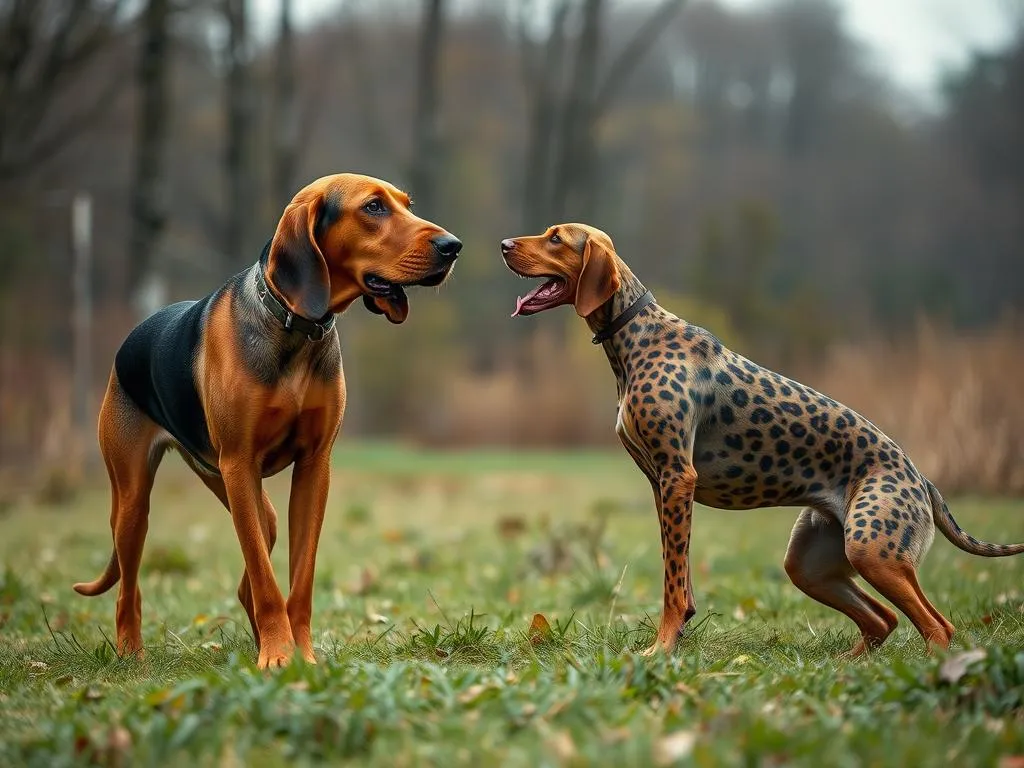
Overview of Dog Breeds
Dog breeds are distinct groups of domestic dogs that share specific traits, characteristics, and behaviors. Understanding these breeds is crucial for potential owners, as each breed comes with its unique needs and qualities. The variety of dog breeds available today ranges from small lap dogs to large working breeds, each serving different purposes, whether for companionship, work, or hunting.
In this article, we will focus on two fascinating breeds: the Bloodhound and the Coonhound. Both breeds have rich histories and distinct characteristics, making them popular choices among dog lovers. We will explore their origins, physical traits, temperaments, health considerations, and training needs, allowing you to understand better how these breeds compare and which one might be the best fit for your lifestyle.
Bloodhound: An In-Depth Look
History and Origin
The Bloodhound has a storied history dating back over a thousand years. Originating in Europe, particularly in Belgium, these dogs were bred for their remarkable sense of smell and tracking abilities. Initially known as St. Hubert Hounds, they were used by monks to track game and assist in hunts. Their exceptional olfactory skills made them invaluable in search and rescue missions, as well as in law enforcement to track down fugitives.
Physical Characteristics
Bloodhounds are large, powerful dogs, typically weighing between 80 to 110 pounds. They possess a strong, muscular build, with males generally larger than females. One of their most distinctive features is their long, droopy ears, which help capture scent particles, enhancing their tracking abilities. Their wrinkled skin adds to their unique appearance, giving them a wise and soulful expression.
Temperament and Behavior
Bloodhounds are known for their gentle and affectionate nature. They are friendly, good-natured, and generally good with children and other pets. However, their strong tracking instincts can sometimes lead to stubbornness, requiring consistent training and socialization. They thrive on companionship and may experience separation anxiety if left alone for extended periods.
Health Considerations
Like any breed, Bloodhounds are prone to specific health issues. Common concerns include hip dysplasia, ear infections due to their floppy ears, and skin problems related to their wrinkles. The average lifespan of a Bloodhound ranges from 10 to 12 years. Regular vet check-ups, a balanced diet, and proper grooming are essential to maintain their health.
Training and Exercise Needs
Training a Bloodhound can be a challenge due to their independent nature. Positive reinforcement techniques work best, as they respond well to treats and praise. Socialization from a young age is crucial to prevent any behavioral issues. As for exercise, Bloodhounds require daily walks and mental stimulation to keep them happy and healthy. Engaging in scent-based activities can help satisfy their natural instincts.
Coonhound: An In-Depth Look
History and Origin
The Coonhound is a group of hunting dogs developed in the United States, primarily for tracking raccoons and other game. Their lineage traces back to various hound breeds, including the English Foxhound and the American Foxhound. Coonhounds were bred for their keen sense of smell and agility, making them excellent hunters. They have been utilized in hunting and outdoor activities for centuries, showcasing their versatility and skill.
Physical Characteristics
Coonhounds are typically medium to large-sized dogs, with most weighing between 40 to 75 pounds. They are known for their strong, athletic build, with long, droopy ears and a distinctive, powerful muzzle. Their coat is usually short and can come in various colors, including black and tan, blue, and red. This breed’s strong physique contributes to its endurance and ability to cover significant distances during hunts.
Temperament and Behavior
Coonhounds are friendly, outgoing, and sociable animals. They are known for their playful demeanor and enjoy being around people and other dogs. Their hunting background means they have a high energy level and require plenty of exercise. While they are affectionate and loyal, Coonhounds can also be stubborn, necessitating consistent training and positive reinforcement techniques.
Health Considerations
Coonhounds are generally healthy dogs, but they can be prone to certain health issues such as hip dysplasia, ear infections, and certain skin conditions. The average lifespan of a Coonhound is about 10 to 12 years. Regular veterinary care, a proper diet, and routine exercise are vital for their overall well-being.
Training and Exercise Needs
Training a Coonhound can be both rewarding and challenging. They are intelligent dogs but can be easily distracted, especially by interesting scents. Consistent training sessions that incorporate positive reinforcement will help them learn effectively. Coonhounds require ample daily exercise, including long walks, hikes, and playtime to expend their energy and stay healthy.
Bloodhound vs Coonhound: A Comparative Analysis
Physical Differences
When comparing Bloodhound and Coonhound, one of the most noticeable differences is their size and build. Bloodhounds are generally larger and heavier, with a more robust appearance, while Coonhounds are leaner and more athletic. In terms of coat and features, Bloodhounds have a more wrinkled appearance with droopy ears, whereas Coonhounds have longer, more streamlined ears.
Temperament and Behavioral Traits
In terms of temperament, both breeds are friendly and sociable but have different energy levels. Bloodhounds are more laid-back, while Coonhounds are more active and playful. Bloodhounds may be more prone to developing separation anxiety if left alone, whereas Coonhounds thrive on outdoor activities and companionship.
Health and Care
Both breeds share similar health concerns, including hip dysplasia and ear infections. However, Bloodhounds may face more skin-related issues due to their wrinkles. Both breeds require regular veterinary check-ups, proper nutrition, and exercise to maintain their health.
Training and Intelligence
Training can be a challenge with both breeds, but the Bloodhound is often seen as more stubborn than the Coonhound. While both breeds are intelligent, Bloodhounds may require a bit more patience and persistence during training sessions. Coonhounds, with their high energy levels, benefit from engaging training methods that keep them stimulated and focused.
Suitability for Different Lifestyles
Choosing between a Bloodhound and a Coonhound largely depends on your lifestyle. Bloodhounds are better suited for families who prefer a more relaxed dog that enjoys companionship and has a strong sense of smell. In contrast, Coonhounds are ideal for active families who enjoy outdoor activities and hunting. Both breeds require ample space to roam, but Coonhounds may need more physical exercise to meet their energy demands.
Popularity and Usage of Each Breed
Bloodhound in Society
Bloodhounds are well-known for their roles in law enforcement and search and rescue operations. Their exceptional sense of smell makes them invaluable for tracking missing persons or fugitives. Beyond their working capabilities, Bloodhounds are also popular family pets due to their gentle nature and loyalty.
Coonhound in Society
Coonhounds have a strong presence in hunting circles, where they are prized for their ability to track raccoons and other game. Their friendly demeanor also makes them great family pets, particularly for active households that enjoy spending time outdoors. Coonhounds are known for their versatility and adaptability in various environments.
Choosing Between Bloodhound and Coonhound
When deciding between a Bloodhound and a Coonhound, consider several factors. Assess your personal lifestyle, family dynamics, and living environment. If you lead a more sedentary lifestyle or have a family that enjoys a calm dog, a Bloodhound may be the better choice. However, if you are active, enjoy outdoor activities, and want a playful companion, a Coonhound could be the perfect fit.
It’s crucial to research each breed thoroughly and consider factors such as exercise needs, grooming requirements, and potential health issues. Talking to breeders, trainers, and current owners can also provide valuable insights.
Conclusion
In summary, the comparison of Bloodhound vs Coonhound reveals two distinct breeds with unique characteristics, history, and temperaments. Both breeds have their strengths and potential challenges, making it essential for prospective owners to consider their lifestyle and environment when choosing between the two.
Understanding the differences and similarities can lead to a more informed decision about which breed aligns best with your needs. Whether you choose a Bloodhound or a Coonhound, both breeds can bring joy, companionship, and adventure to your home.
FAQs
What are the key differences between Bloodhounds and Coonhounds?
The primary differences lie in their size, energy levels, training challenges, and socialization needs. Bloodhounds are generally larger and more laid-back, while Coonhounds are more active and playful.
Are Bloodhounds good family pets?
Yes, Bloodhounds are known for their gentle and affectionate nature, making them great family pets, especially in homes where they can receive attention and companionship.
Do Coonhounds require a lot of exercise?
Yes, Coonhounds are high-energy dogs that require ample daily exercise, including long walks, hikes, and playtime to keep them happy and healthy.
What health issues should I be aware of with these breeds?
Both breeds can face health concerns such as hip dysplasia and ear infections. Bloodhounds may also experience skin issues related to their wrinkles, while Coonhounds may have more agility-related injuries.
What training methods work best for each breed?
Positive reinforcement techniques work well for both Bloodhounds and Coonhounds. However, Bloodhounds may require more patience during training due to their stubbornness, while Coonhounds benefit from engaging, energetic training sessions.
References
- Visit reputable breed-specific organizations for more information.
- Consult veterinary resources for health and care tips.
- Explore dog training books and websites for additional guidance on both breeds.









